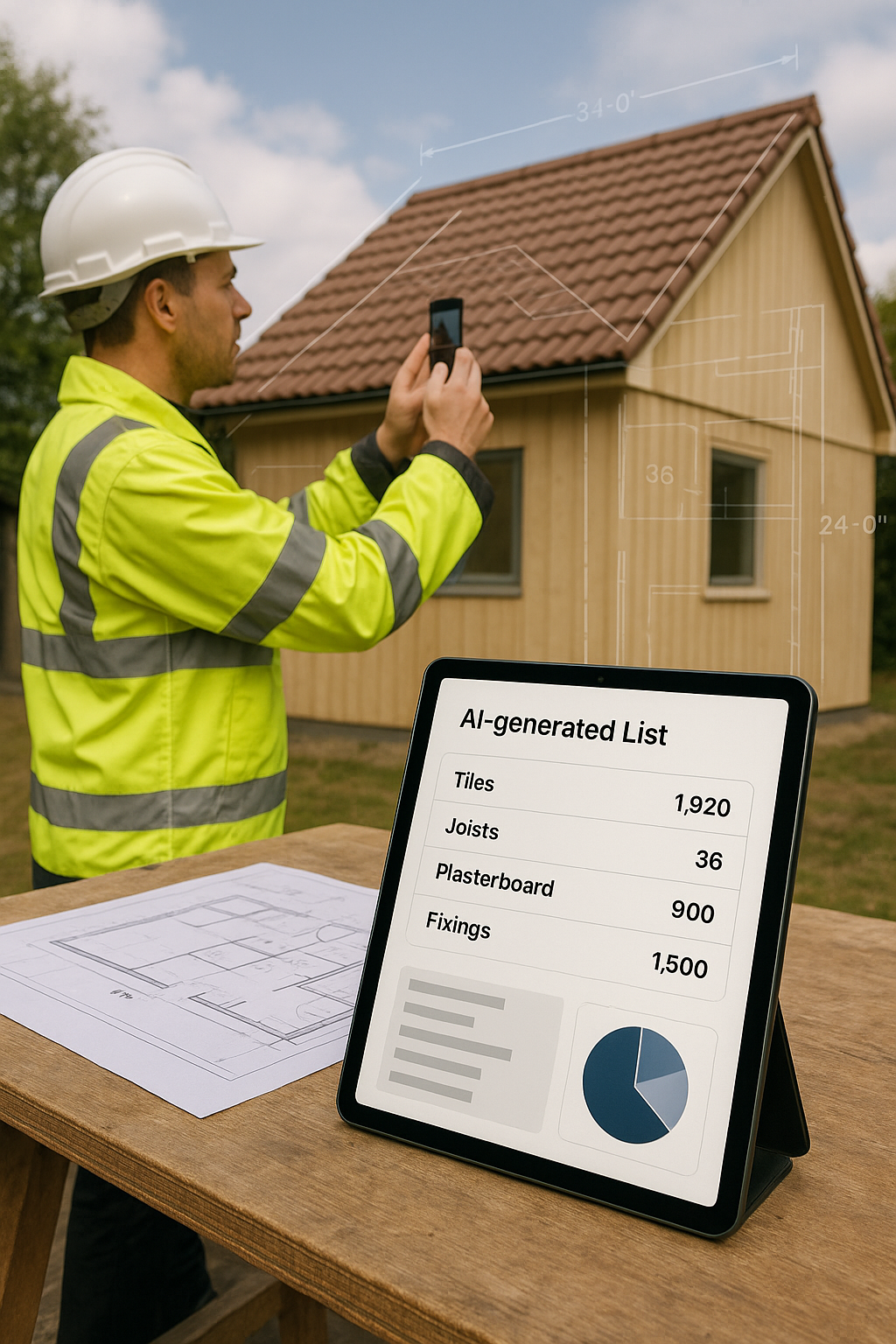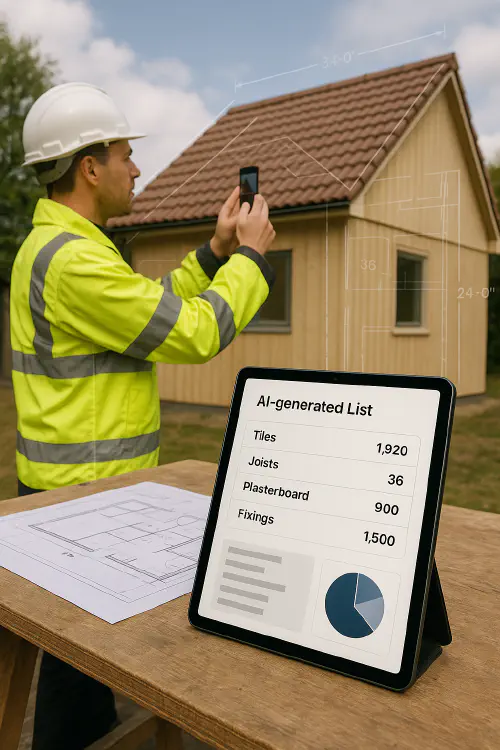
Generate a materials list from plans or photos with AI: fast takeoffs for small contractors
Generate a materials list from plans or photos with AI: fast takeoffs for small contractors
Category: Tools, Materials & Tech • Niche: AI automations, estimating, takeoffs

UK tradesperson using a phone to capture a roof while an AI-generated materials list shows on a tablet
- Contents: Who this is for • Quick answer • How AI takeoffs work • Set up: from photos vs from plans • Accuracy and UK pitfalls • Recommended tools • Workflow you can copy • Costs and ROI • FAQs
Who this is for
Small UK contractors and sole traders who spend evenings doing takeoffs: roofers, builders, carpenters, plasterers, kitchen/bath installers, and maintenance firms reading PDFs or snapping photos, then building a shopping list by hand.
Quick answer
- Yes, you can generate a usable materials list in minutes using AI or assisted takeoff tools.
- For roofs or simple rooms, photos from your phone can be enough to get areas and counts. For full builds and extensions, you’ll get better accuracy by uploading drawings.
- Expect to sense-check pitch, thicknesses and UK product specs. AI is fast, but it will guess if your inputs are vague.
How AI takeoffs work
AI takeoff tools analyse images or PDFs to detect shapes, lines and symbols, then convert them into quantities. Examples from industry explain the process and terminology:
- Material takeoff is simply a detailed list of materials and quantities derived from drawings. See overviews from Autodesk and Procore for definitions and measurement types (count, area, volume, linear).
- Modern tools add computer vision to speed up detection and measurement, then map these to a bill of materials.
Set up: from photos vs from plans
There are two reliable routes for small UK jobs:
A. From photos (fast for roof repairs, small refurbs)
- Take clear, square-on photos or a short video walkaround. Capture each elevation and corners.
- For roofs, include a close-up of a tape on a tile for scale, and at least one pitch reading (phone inclinometer works).
- Use an app that translates imagery into measured planes, then exports a report or CSV.
Pros
- Quick on-site, good for quotes and emergency works.
Cons
- Satellite imagery in the UK can be dated; trees and dormers cause errors. You still need to confirm pitch and materials.
B. From plans/PDFs (best for extensions, fit-outs)
- Upload architect’s PDFs or trace over scanned drawings. Set one known dimension to calibrate.
- Tag elements by type so the software can build a materials list automatically.
Pros
- More accurate, easier to revise when drawings change.
Cons
- Needs clean plans; you must pick UK products to avoid US specs creeping in.
Accuracy and UK pitfalls
- Pitch and thickness: Always set roof pitch and insulation/plasterboard thickness explicitly. Defaults are often US-based.
- Waste factors: UK merchants pack in specific lengths and bundle sizes; add waste that matches local pack sizes.
- BST/GMT and units: Check units are metric and time zones don’t shift appointments if you auto-schedule surveys. See our guide on Outlook ↔ ServiceM8/Jobber/Tradify: stop duplicate calendar entries and fix BST/GMT shifts.
- Product naming: Pick UK SKUs for tiles, plasterboard, fixings. Merchants like Jewson and Travis Perkins can sanity check lists against stock.
Recommended tools
We prioritised UK-available options. Use what matches your jobs:
- Photos/roof focus: VELUX Roof Pitch apps on iOS and Android to capture pitch; pair with a roof measurement/report service like Roofr or pro tools reviewed by Checkatrade.
- Plans/PDF takeoff with AI assistance: Kreo detects and classifies items on drawings to generate quantities and BoQs. HBXL’s EstimatorXpress with PlansXpress offers UK libraries and outputs merchant-ready lists.
- Merchant-powered estimating: Jewson Project Estimator and Travis Perkins Estimating Service generate full materials lists and pricing from plans.
- Roofing specific calculators: Marley tools help validate quantities for UK tiles and systems.
Workflow you can copy
Here’s a simple, repeatable flow for a small contractor.
1. Capture and calibrate
- Photos: Shoot each elevation, corners, and a tape close-up for scale; record roof pitch.
- Plans: Upload the PDF and set a known dimension.
2. Detect and tag
- Let the software detect areas, linear edges and counts. Tag what matters to your trade: tiles and ridge, joists and noggins, plasterboard and tape, fixings by type.
3. Export and price
- Export CSV or PDF materials list. Cross-check with a UK merchant for pack sizes and lead times. Keep a template with your preferred SKUs.
4. Build the quote pack
- Include a simple takeoff snapshot and a one-page scope with assumptions, plus waste factors. Clients like seeing the workings.
5. Review on site
- On first visit, verify one dimension and pitch, adjust quantities if the site differs from the drawings.

Annotated takeoff overlay with AI-generated materials list
Costs and ROI
- Tools range from free pitch apps to paid AI takeoff platforms and merchant services. As a rule of thumb, saving 1 to 2 hours per quote or catching one mis-measure per month pays for most subscriptions.
- Merchant estimating is often bundled with supply, which can be cost neutral if you buy materials there.
FAQs
Can AI measure from poor scans or photos?
It can, but accuracy drops. Always provide one known measurement or pitch, and sense-check outputs.
Will it work for loft conversions and extensions?
Yes, but upload the drawings. You’ll get better structural and insulation quantities than from photos.
What about MEP trades?
Electrical contractors use symbol-counting tools like Countfire; plumbers often rely on merchant lists or manual takeoffs, but photo ID apps from suppliers can help with parts.
Is this acceptable for tendering?
For domestic work and small builders, yes with a check. For formal tenders, get a QS to review or export a BoQ and align with the spec.
Want to slash training times and increase revenue per Engineer? Join our Waitlist: https://trainar.ai/waitlist